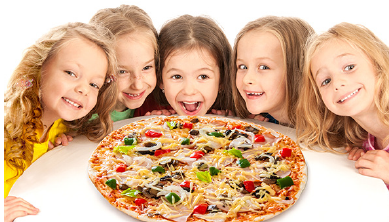Pizzas and things
This problem solving activity has a number (multiplication and division) focus.
Pizza Place has just two big tables.
If 7 people can sit around each table, how many people can be seated altogether?
Chicken N Chips also has two big tables.
If 16 people altogether are seated, how many people are at each table?
- Find half and double of given sets.
- Devise and use problem solving strategies (draw a picture, use equipment, guess and check, be systematic).
This problem explores doubling and halving.
Doubling is the first step towards finding any multiple of a number and halving is the beginning of work with fractions.
Doubling and halving are inverse operations. Students need opportunities to see and understand that one operation cancels out the other. Multiplying by four and finding quarters is another example of inverse operations.
Much of mathematics is based around inverse operations. They are important, for instance, in solving equations. One side of an equation can be simplified by using an inverse operation to cancel out the operation on that side. For example, if four times something equals 12, then we can undo the ‘four times’ by applying its inverse – ‘taking a quarter’. So a quarter of four times something is the something itself. And a quarter of 12 is 3. The something then, is 3.
This application of inverses occurs at every level including calculus at Levels 7 and 8 (the inverse of differentiation is integration) and things called matrices at university level.
The Problem
Pizza Place has just two big tables. If 7 people can sit around each table, how many people can be seated altogether?
Chicken N Chips also has two big tables. If 16 people altogether are seated, how many people are at each table?
Teaching Sequence
- Introduce the lesson with some guessing games, for example,
I am a number which is half of 10, what number am I?
I am a number which 4 more than 3, what number am I?
I am a number which is 5 less than 10, what number am I?
I am a number which is double 10, what number am I? - Read the problem to the class.
- Brainstorm ways to solve the problem.
- As the students work on the problem, ask questions that focus on the number strategies that they are using.
Tell me how you got your answer?
Can you think of a way to check that you are correct? - Share solutions.
Extension
Vary the number of people.
Pose problems with 4 tables and smaller numbers of people at each. Students might use half and half again, or double and double again strategies for these problems.
Solution
Students might use a range of representations to show that Pizza Place can hold 14 people, and that 8 people sit at each of the Chicken N Chips tables.
